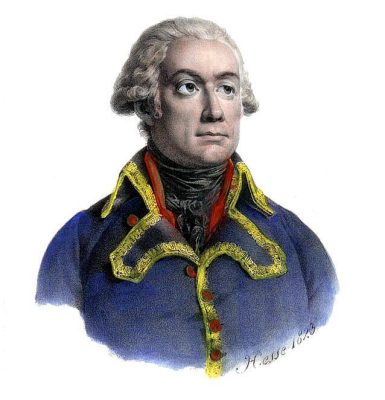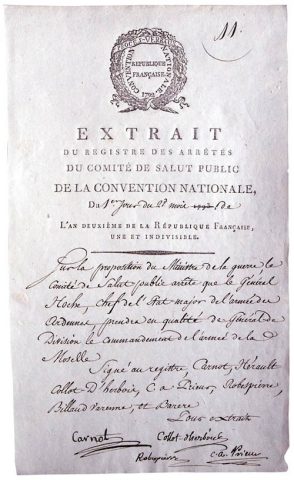
The Committee of Public Safety or CPS (French, Du Comite de Salut Public) was a powerful political body during the radical period of the French Revolution. Formed in the spring of 1793, it was initially tasked with helping the National Convention respond more swiftly and effectively to threats and problems. Within months, its influential members had acquired considerable power and turned the Committee of Public Safety into a de facto executive cabinet, overseeing the Reign of Terror and disposing of political rivals.
Summary
Formed by the National Convention in April 1793, the Committee was intended to function as a war council and a body for maintaining internal security. It contained nine seats (later extended to 10, then 12) which were rotated monthly, a procedure intended to stop one individual or faction from accumulating too much power.
Despite this restriction, within six months the Committee of Public Safety was dominated by radicals. Under their control, the Committee began to operate efficiently but also autonomously from the legislature. By late 1793, the Committee was effectively directing the National Convention rather than acting on its behalf. The Committee’s members – men like Maximilien Robespierre, Louis Saint-Just and Georges Couthon – became virtual leaders of the revolution.
Many consider the Committee of Public Safety as the body most responsible for the Reign of Terror. While this is open to debate, it seems clear the Committee both endorsed and contributed to the use of state terror in 1793-94.
Other committees
The Committee of Public Safety was by no means the first powerful committee of the French Revolution. All three national legislatures established committees to deal with problems or issues, including security and potential threats.
The National Constituent Assembly had its own police committee called the Comité des Recherches (‘Search Committee’). Under the Legislative Assembly, it was re-formed as the Comités de Surveillance (‘Committee of Surveillance’). With the election of the National Convention, this group became the Comité de Sûreté Générale, or the Committee of General Security (CGS).
All of these committees were responsible for protecting the security of the new regime. They surveilled and prosecuted foreign spies and counter-revolutionaries, controlled internal passports, dealt with counterfeiters and oversaw security in the provinces.
Formation

Events and difficulties in the spring of 1793 saw demands for stronger leadership and, in turn, the emergence of the Committee of Public Safety.
The trial and execution of Louis XVI in January 1793 left the Convention without an executive. It functioned this way for several months, however, the poor progress of the Revolutionary War and the growing counter-revolution in the Vendée sparked calls for stronger leadership in the Convention.
Matters came to a head in April 1793. On April 5th, Charles Dumouriez, a former foreign minister and one of France’s best military commanders, defected to the Austrians. It soon emerged that Dumouriez had been negotiating with the Austrians for weeks and had attempted to organise a counter-revolutionary force to seize control of Paris.
This news rocked the National Convention, discredited the Girondin deputies who supported Dumouriez and triggered calls for action. The following day, at the urging of Georges Danton, the Convention created the Committee of Public Safety (CPS).
The role of the CPS was to receive and monitor intelligence, handle the day-to-day business of the war and report weekly to the Convention in session. The CPS was authorised to act on behalf of the Convention but had to report to the Convention weekly. The deputies of the Convention could then censure the committee, overrule its decisions or remove its members, though in practice this never happened.
The CPS had no intrinsic power: what it had instead was responsibility, autonomy and secrecy. Its members met behind closed doors. There were no witnesses or other deputies present and their discussions remained secret.
Just as importantly, the CPS could make decisions without consulting the Convention. The first Committees were a microcosm of the Convention, containing a mix of moderates and radicals. During its first weeks, the members of the CPS worked collaboratively, inspired by a sense of unity and common purpose. Their measures were successful too, which encouraged the Convention to place even more trust in this group.
Membership and operation

The Committee’s descent into authoritarianism began with the election of Robespierre to the CPS on July 27th 1793. The membership of the Committee changed little over the next year; the Convention re-endorsed its members every month and in September voted to increase the CPS to 12 members.
Collectively, this group became known as the ‘Great Committee’ or the ‘Twelve Who Ruled’. They had an average age of just 30 and eight of the 12 were lawyers. Working on a long table covered with green baize, sometimes for entire days and nights, the Committee crafted responses to military threats, public insurrection and economic despair. Not all members were present at any given time; individual committeemen were often absent on visits to the provinces or the army.
Each CPS member was allocated portfolios or areas of oversight. Robespierre was responsible for policing and religion, while his ally Louis Saint-Just and Lazare Carnot both handled war strategy and planning. Robert Lindet was in charge of recruiting and supplying the army, a task he managed with some success. The radical journalist Bertrand Barère drafted legislation, represented the CPS in the National Convention and reported on its actions.
Centralisation of power
How did the Committee of Public Safety come to wield so much power? Several clues can be found in the proceedings of September 1793, when the National Convention gave the CPS several new powers and responsibilities.
On September 14th, the CPS was given sole power to appoint deputies to other committees. Three days later, the Convention passed the Law of Suspects and, later that month, the Law of the Maximum. These powers encouraged the CPS to take a more active, interventionist role in government, war policy and national security.
The expanded powers also allowed the members of the CPS to dispatch their enemies. Among those who went to the guillotine in the last three months of 1793 were Marie Antoinette, Jacques Brissot and several of his fellow Girondins, Pierre Vergniaud, Olympe de Gouges, the former Duke of Orleans, the Rolands, Jean-Sylvain Bailly and Antoine Barnave.
By December 1793 the CPS was not only politically powerful, it could swiftly silence its opposition. On December 4th, the Convention formalised the power of the CPS by passing the Law of 14 Frimaire, later dubbed the ‘Constitution of the Terror’. This law handed the Committee de facto executive power while declaring the National Convention the “sole centre of government initiative”.
“Controversy over the Committee of Public Safety and its place in the history of the revolution began even before it disappeared. It is credited, on the one hand, for overseeing the defence of the country and guiding France to victory in war over almost all the other nations in Europe. But on the other hand, it is condemned for overseeing the machinery of the Terror and putting in place what has often been characterised as a Jacobin dictatorship. Whether the former required the latter lies at the heart of the debate.”
Paul R. Hanson, historian

1. The Committee of Public Safety (CPS) was a powerful committee of the National Convention, formed in April 1793 following the defection of General Dumouriez to the Austrians.
2. The CPS began as a nine-man committee with few intrinsic powers. Its mission was to oversee the war effort and national security, reporting weekly to the Convention. Its members were elected each month.
3. By September 1793 the CPS had expanded to 12 men and its membership rarely changed. During this month the Convention passed several measures that increased the power of the CPS, such as the Law of Suspects and the General Maximum.
4. As its powers increased, the CPS also began eradicating its political opponents. Several notable figures were guillotined between October and December 1793, including the Girondin leader Jacques Brissot.
5. In December 1793 the Convention passed the Law of 14 Frimaire, which formalised the role of the CPS, giving it de facto executive power.

The Convention forms the Committee of Public Safety (April 1793)
Madame de Staël on the power of Robespierre and the CPS (1798)
Citation information
Title: ‘The Committee of Public Safety’
Authors: Jennifer Llewellyn, Steve Thompson
Publisher: Alpha History
URL: https://alphahistory.com/frenchrevolution/committee-of-public-safety/
Date published: September 14, 2019
Date updated: November 11, 2023
Date accessed: July 26, 2024
Copyright: The content on this page is © Alpha History. It may not be republished without our express permission. For more information on usage, please refer to our Terms of Use.
